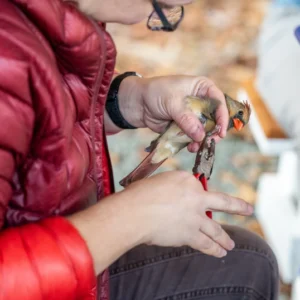Nature Canada Comments on Proposed Changes to Endangered Species Act
Krista Adams
Senior Permits & Agreements Specialist
Ministry of Natural Resources
Policy Division, Species at Risk Branch
300 Water Street, Floor 2
Peterborough Ontario
K9J8M5
Re: Comments on the Regulation Proposal Notice to the Endangered Species Act (EBR Registry
number 011-7696)
Dear Ms. Adams,
Please accept the following additional correspondence from Nature Canada in regards to the Regulation
Proposal Notice EBR Registry Number: 011-7696. We provide these comments specifically in response to
the “Additional Detail to accompany Environmental Registry notice (EBR Registry Number: 011-
7696)”, published on January 24, 2013. We would like to thank you for the opportunity to
comment on these proposed regulations, and for releasing the additional detail to accompany
the proposal. Nature Canada represents a network of over 40,000 supporters and more than 350
nature and naturalist organizations that reach approximately 100,000 Canadians. We are Canada’s voice
for nature.
The proposed regulatory amendments discussed in EBR 011-7696 are a source of great concern to
Nature Canada. It is clear that these amendments will authorize potentially harmful activities to occur
beyond the control and knowledge of the Ministry of Natural Resources’ (MNR) officials, even when
impacting Ontario’s most sensitive species and habitats. We feel this proposal is in direct opposition to
the purpose of the Endangered Species Act (ESA), which is to “protect species that are at risk and their
habitats, and to promote the recovery of species that are at risk”.
MNR’s proposal to exempt “already approved or planned activities” from permitting or even registration
with MNR when species at risk and their habitat will be impacted has frightening implications. The
recently released additional details specifying the types of and timeframes for activities that will be
covered under the proposed exemptions are so broad that our fears have only been confirmed. The
proposed changes leave species and habitats vulnerable to threat and exploitation, even after the
Province promises to provide them protection by listing species or by classifying habitat requirements.
These exemptions will apply to newly listed species at risk, species at risk newly discovered at a site, or
any newly protected habitat for species at risk. In our view this proposal lacks alignment with a
precautionary approach to species at risk protection and recovery. Furthermore, this proposal appears
to undermine years of investment by the Ontario government to protect and recover its listed species
and their habitats. Is that what Ontario taxpayers want to see?
The proposed changes fail to consider present and ongoing threats to Ontario’s species at risk. Species
that are newly listed may be experiencing rapid declines and may in fact be threatened by the very
activities that will be exempt through this proposal. New species are continually being assessed by the
Committee on the Status of Species at Risk in Ontario (COSSARO) and subsequently added to Ontario’s
list of Endangered Species, and species already listed are monitored which on occasion results in a
modification of their designation. To ignore all future alterations to the list of Endangered Species,
species whose real world populations are constantly changing, is unreasonable.
The current permitting process ensures that before development occurs detailed, site-specific
inventories are conducted in order to identify and address potential threats to species at risk. Despite
these inventories new species are on occasion identified within the area after permits have been issued.
These species deserve the same level of consideration and protection given to every listed species in
Ontario, and their well being should not be ignored simply because they are cryptic or difficult to
identify. Indeed, that may be one of the major factors for their designation as at-risk. To propose
exemptions for species newly found at a site will undermine protection for species and their habitats
that are identified through the municipal planning process. A process which is based on continually
refining knowledge gained through multiple levels of study, and which should be upheld.
Ontario Nature in partnership with Wildlife Conservation Society Canada recently completed an analysis
of the 65 Threatened and Endangered species listed by COSSARO prior to the passing of the ESA in 2007.
This analysis revealed that for 59 out of the 65 species still awaiting habitat protection habitat loss or
degradation is a key threat. These 65 species have been waiting for six years to have their habitat
protected, and these exemptions would negate the effectiveness any protection the long awaited
designation could offer on lands where development is planned or ongoing, easily representing a
significant area for these species. This is particularly concerning as habitat protection for these species is
scheduled to be released as soon as later this year. These species have been waiting for habitat
protection for years, and when they are mere months from having their habitat designated, MNR is
suggesting removing all usefulness of that protection.
Many of the conditions attached to the proposed exemptions note that registration of an undertaking
with MNR may not be mandatory in all cases. The extent of activities that would be allowed without any
discussion with MNR is overwhelmingly broad. In particular the proposal that projects will have a full
two years to create a mitigation plan, while development proceeds, is startling. And that these plans will
only need to be presented to MNR upon request is outright disturbing. Too much faith is being put in
the good intentions of industry, a sector whose primary goal is profit and shareholder satisfaction.
Without specific, scientifically-informed guidance on which sorts of developments are or are not likely to
impact species at risk and their habitats, all proposed developments must have a full, reviewed and
approved mitigation plan in place before any development begins. Any other alternative has too great a
potential for disastrous results and abuse by proponents who are – necessarily – driven by factors
beyond species protection and recovery. The provincial government has a fiduciary duty to provide
oversight on these matters.
In order to monitor and enforce compliance with the conditions set in this proposal MNR will require
significant additional capacity, capacity which MNR has not shown it has intentions of filling. We fear the
emphasis of this proposal on individuals or business to, essentially, voluntarily follow rules and
established regulations will make it extremely difficult if not impossible to regulate and enforce
conformity of the conditions mentioned in this proposal. Through these exemptions the Ministry’s
ability to uphold the law and to track and address impacts will be completely undermined.
Registration with MNR and permit approval for potentially harmful developments must be mandatory.
The issuance of permits is critical for MNR to effectively monitor and control the actual and cumulative
impacts of development and related activities within Ontario, and to enforce compliance with rules and
regulations. The process of issuing permits is also crucial in informing industry of its standards of
conduct and public responsibilities when impacting species at risk. If industry is neither made aware of
acceptable standards nor held accountable through the permit approval and renewal process, we fear
that Ontario’s most at-risk species and habitats that will suffer the cost.
Permits are able to deal with specific issues as they arise and should continue to be used, not replaced
with exemptions for industry. We recommend that instead of removing the permit process in the name
of streamlining the process and increasing administrative efficiencies MNR places the financial burden of
permit acquisition and research on the shoulders of those who will benefit from them as an alternative
funding method (i.e., a “polluter pays” approach). This action will help to relieve MNR’s financial burden
while still allowing for strong implementation of the Act and greater investment in recovery activities.
Nature Canada supports the following statement made by Ontario Nature:
We strongly disagree with the regulatory impact statement which states that “the anticipated
environmental risks and consequences associated with this proposal are likely neutral.” There is
no information or data provided to support this statement. The proposal is to exempt existing or
planned activities in situations where a species is newly listed, where it is newly found on a site or
when habitat is newly protected. Given the breadth of this proposal, it is hard to comprehend
how MNR could contend that the impacts will be neutral.
The proposed regulation is presented for public consultation as an approach “to improve the
implementation of the ESA”. A cynical observer may suggest that positive terms such as ‘efficiency’ and
‘streamlining’ are used to obscure the fact that this proposal is a relinquishment of MNR’s responsibility
under the ESA. In particular the language used in the document of “Additional Detail to accompany
Environmental Registry notice” is extremely difficult to understand. If a team of educated professional in
the environmental sector working together had difficultly reviewing many of the finer points of this
document how can the general public be expected to understand the full implications of this proposal?
We therefore recommend that if the Ministry is going to continue this line of action, than MNR should
produce and consult upon a new document containing greater transparency in language for public
consultation before there is any further progression with these proposals.
Not all provinces and territories in Canada have their own dedicated endangered species legislation.
Ontario is among the provinces that do, and the Endangered Species Act is a strong piece of legislation
for which the Government of Ontario and Ontarians alike should be proud. Passing these proposed
amendments will weaken what is considered an important piece of legislation and will set the
wrong national precedent. Please continue to make the effective implementation of this Act a
priority, and continue to make Ontario’s treatment of endangered species and the habitat they rely on
an excellent example to the rest of Canada.
Thank you again for the opportunity to further comment on this regulatory amendment proposal notice
concerning the ESA. We recognize that this is not simply an Ontario issue as species at risk do not
stop at borders. Instead we see that this proposal concerns all Canadians and we draw a direct
parallel between this proposal and the potential changes the federal government has hinted at
making to the Species At Risk Act for months. We stand in support of our provincial Canadian
Nature Network (CNN) partner, Nature Ontario, who is the CNN’s primary voice in Ontario. We
trust that our concerns and recommendations will be taken into consideration. Please do not hesitate to
contact us should you have any questions regarding this correspondence.
Ian Davidson
Executive Director
Nature Canada



